A wooden gazebo is a popular outdoor structure used for various purposes, such as for relaxation, and entertainment, or as a decorative feature in gardens or parks. One of the key considerations when building a wooden gazebo is its height, which several factors can influence.
Understanding the factors that affect the height of a wooden gazebo is important for ensuring that the structure is safe, functional, and aesthetically pleasing.
In this article, we will explore the structural and design considerations that impact the height of a wooden gazebo, as well as the maximum height limitations imposed by building codes, zoning regulations, and site-specific conditions.
Finally, we will examine examples of wooden gazebo heights and provide some final considerations for wooden gazebo construction.
How high can a wooden gazebo be: A wooden gazebo’s height is influenced by structural considerations, design, and location. Building codes, zoning regulations, and site-specific conditions also impact the maximum height limitations. Understanding these factors is crucial for constructing a safe and functional wooden gazebo.
Definition of a wooden gazebo
A wooden gazebo is a freestanding, roofed structure that typically features an open design supported by posts or columns. It is typically made of wood and is commonly found in gardens, parks, or outdoor recreational areas.
Wooden gazebos may vary in size, shape, and design, but they are generally characterized by their open design, decorative features, and ability to provide shade and shelter for outdoor activities.
They are often used for outdoor dining, entertaining, relaxation, or as a decorative feature in landscaping.
How high can a wooden gazebo be?

The height of a wooden gazebo can vary depending on several factors, such as the style of the gazebo, its intended use, and local building codes.
However, some general guidelines can help determine the maximum height for a wooden gazebo. Here are some steps to consider:
Structural considerations
Structural considerations are an important factor when determining the maximum height of a wooden gazebo. The materials used in construction, the engineering and design requirements, and building codes and regulations can all impact the height of a wooden gazebo.
The type and quality of wood used and the thickness of the posts and roof framing can influence the maximum height of a wooden gazebo. The structural design and engineering requirements can impact the height of a wooden gazebo, especially for larger or more complex structures.
Local building codes and regulations may also dictate outdoor structures’ minimum and maximum height requirements. Ensuring that the structure is built to meet these requirements is crucial for ensuring the safety and longevity of the wooden gazebo.
Materials used in construction
The type and quality of wood used in construction are important factors when determining the maximum height of a wooden gazebo. The wood used should be durable, weather-resistant, and able to withstand the weight of the roof and any additional features such as lighting or fans.
Common types of wood used for gazebos include cedar, redwood, and pressure-treated pine. These woods are known for their natural resistance to decay and insects. The thickness of the wood posts and roof framing can also impact the maximum height of a wooden gazebo.
Thicker posts and framing can provide added stability and support for taller structures. It is important to select wood that is appropriate for the intended use and location of the gazebo to ensure that it can withstand the elements and provide long-lasting durability.
Engineering and design requirements
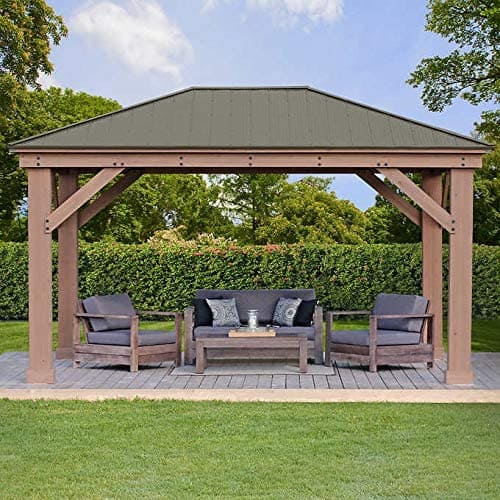
Engineering and design requirements are important factors when determining the maximum height of a wooden gazebo, especially for larger or more complex structures.
The structural design and engineering requirements can impact the height of a wooden gazebo by determining the appropriate load-bearing capacity of the posts, framing, and roof.
Factors such as wind and snow loads, as well as the structure’s overall design, can influence the maximum height of a wooden gazebo. Diagonal bracing, reinforcement of joints, and other design elements can also impact the height and stability of a wooden gazebo.
It is important to ensure that the gazebo is designed and engineered to withstand the elements and to meet local building codes and regulations. Hiring a professional designer or engineer can ensure the gazebo is safe, functional, and aesthetically pleasing while complying with local regulations.
Building codes and regulations
Building codes and regulations can impact the maximum height of a wooden gazebo. Local building codes and zoning regulations may specify minimum and maximum height requirements for outdoor structures, including gazebos.
These regulations are in place to ensure the structure’s safety and stability and that it complies with zoning requirements and is not obstructing any views or access. Building codes and regulations may also specify requirements for the size and spacing of the posts and framing and the thickness and type of roofing materials.
Researching and understanding local building codes and regulations before constructing a wooden gazebo is important to ensure it is safe, functional, and compliant with local laws.
Design considerations
Design considerations can impact the maximum height of a wooden gazebo. The style and design of the gazebo can influence its height, as well as its intended use and location.
For example, a gazebo with a low-pitched roof and a smaller footprint may be better suited for a small backyard. In contrast, a larger gazebo with a higher roof may be more appropriate for a larger garden or park setting.
The location and surroundings of the pavilion can also impact its height, such as if it is placed near trees or other structures.
The intended use of the pavilion can also influence its height, such as if it is used for outdoor dining, entertaining, or as a decorative feature in landscaping.
It is important to consider these design factors when determining the maximum height of a wooden gazebo to ensure that it is functional and aesthetically pleasing while also complying with local building codes and regulations.
Style and aesthetics
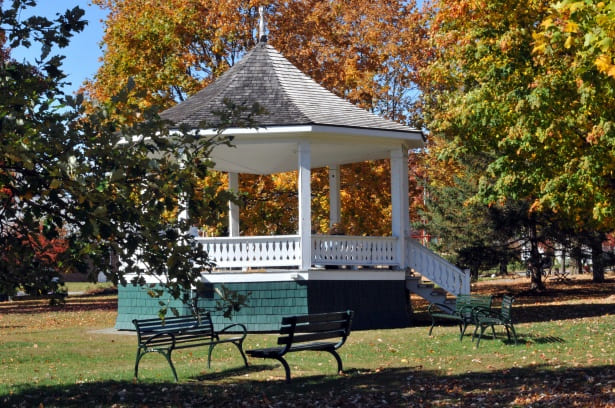
Here are some points to consider regarding style and aesthetics when designing a wooden gazebo:
Roof Pitch
The roof’s pitch can greatly affect the overall height of the gazebo. A lower-pitched roof will lower overall height, while a steeper-pitched roof will result in a taller gazebo. Consider the style of the surrounding buildings or landscaping when deciding on the roof pitch.
Ornamentation
The addition of ornamental elements such as finials, trim, and latticework can add height to a gazebo. However, keep in mind that too much ornamentation can make a gazebo appear overwhelming or cluttered.
Size and Proportion
The size and proportion of the gazebo should be in keeping with the size of the surrounding space. A larger gazebo may be appropriate for a larger garden or park, while a smaller gazebo may be better suited for a small backyard.
Materials
The choice of materials can impact the aesthetics of the gazebo. Wood is a popular choice for gazebos, but it can be stained or painted to match the surrounding landscape or architecture.
Colour
The colour of the gazebo can also affect its overall appearance. Consider the surrounding landscape and choose a colour that complements it.
When designing a wooden gazebo, it is important to consider the style and aesthetics to ensure that it complements its surroundings and adds to the overall look and feel of the space.
Site conditions and location

Here are some points to consider regarding site conditions and location when designing a wooden gazebo:
Terrain: The terrain of the site where the gazebo will be located can affect the height of the gazebo. A sloped site may require the gazebo to be built on a foundation or platform, which could affect the overall height.
Sun Exposure: The location of the gazebo in relation to the sun can also affect its height. If the gazebo will be used during the hottest part of the day, consider adding shading elements such as a trellis or pergola, which could increase the overall height.
Wind Exposure: The location of the gazebo in relation to wind can also affect its height. A gazebo that is located in a windy area may need to be designed with a lower profile or have additional structural supports to prevent damage.
Proximity to Other Structures: The proximity of other structures, such as buildings, trees, or fences, can also affect the height of the gazebo. If the gazebo is located near other structures, consider their height and how they might impact the overall height of the gazebo.
Building Codes and Regulations: It is important to check with local building codes and regulations to ensure that the height of the gazebo complies with the requirements in the area.
When designing a wooden gazebo, it is important to consider the site conditions and location to ensure that the gazebo is safe and functional and provides an enjoyable outdoor space.
Design Considerations for Wooden Gazebos: Intended Use
Here are some points to consider regarding intended use when designing a wooden gazebo:
Outdoor Dining
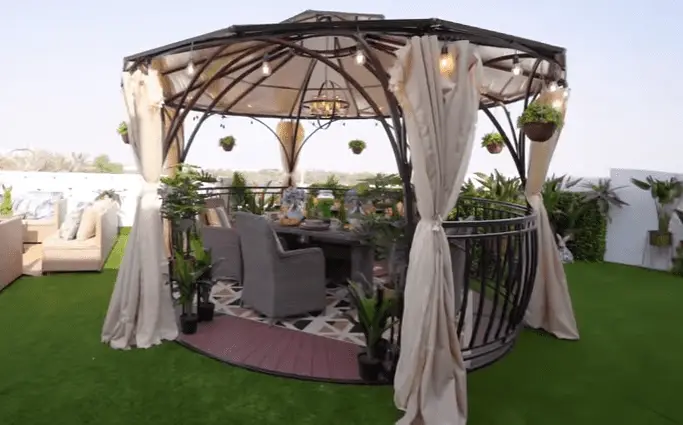
If the gazebo is used for outdoor dining, consider the height of the furniture and appliances that will be used in the space. The gazebo should be tall enough to accommodate standing and sitting guests comfortably.
Entertaining
If the gazebo is used for entertaining, consider the size of the space needed for guests to move around and socialize. The gazebo should be tall enough to accommodate standing guests and any decorations or lighting that may be added.
Decorative Feature
If the gazebo is intended to be a decorative feature in landscaping, consider its overall height in relation to other elements in the surrounding space. The height of the gazebo can be used to create visual interest and draw the eye to the space.
Storage or Shelter
If the gazebo is used for storage or as a shelter for outdoor equipment, consider the size of the equipment that will be stored in the space. The gazebo should be tall enough to accommodate any equipment that may need to be stored while also allowing for adequate ventilation.
When designing a wooden gazebo, it is important to consider its intended use to ensure that it is functional and serves its intended purpose.
Determining the Height of a Wooden Gazebo
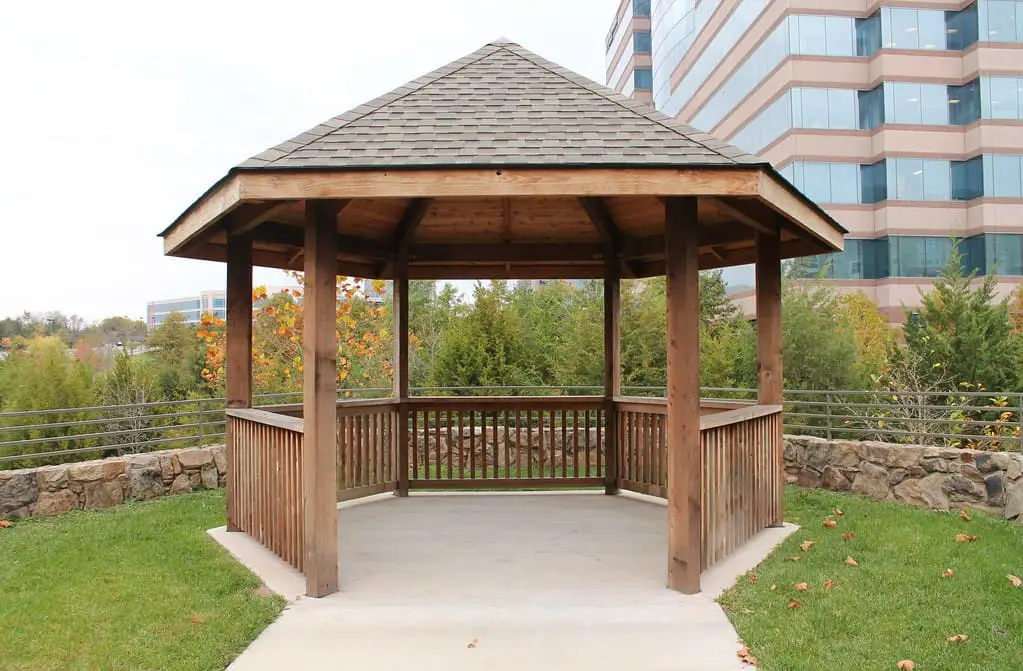
The height of a wooden gazebo depends on various factors such as its style and design, intended use, location, site conditions, and local building codes and regulations.
Generally, a wooden gazebo can range in height from 8 to 14 feet.
However, it is important to consider the abovementioned factors when determining the appropriate height for a wooden gazebo.
For example, a smaller backyard may require a lower-height gazebo with a smaller footprint. At the same time, a larger garden or park may be able to accommodate a taller gazebo with a higher roof.
It is recommended to consult with a professional contractor or local building department to ensure that the wooden gazebo meets the necessary safety and building regulations.
Maximum Height Limitations for Wooden Gazebos
The maximum height of a wooden gazebo may be limited by local building codes and regulations, which vary depending on the location and zoning of the property.
These codes are generally designed to ensure that structures are safe, structurally sound, and aesthetically appropriate for the surrounding area.
The maximum height limitations for a wooden gazebo will depend on its size, location, and intended use.
For example, a small gazebo in a residential backyard may have different height restrictions than a large gazebo in a public park or commercial property.
It’s important to research and complies with local building codes and regulations when planning to build a wooden gazebo, as failure to do so may result in fines, legal penalties, or the need to dismantle or modify the structure.
Consulting with a professional builder or architect can also help ensure that the design and construction of the gazebo meet all requirements.
Importance of Building Codes and Regulations in Construction
Building codes and regulations are standards and guidelines established by local and national authorities to ensure that buildings and structures are safe, structurally sound, and meet certain minimum requirements.
These codes cover a wide range of aspects related to construction, such as building materials, structural design, electrical and plumbing systems, fire safety, and accessibility.
Building codes and regulations are typically enforced by local building departments or other regulatory agencies, which may require permits and inspections throughout the construction process to ensure compliance.
Failure to comply with building codes and regulations can result in fines, legal penalties, or the need to dismantle or modify the structure to meet requirements.
When building a wooden gazebo, it’s important to research and comply with all applicable building codes and regulations to ensure the structure is safe and legal.
This may involve obtaining permits, following specific construction guidelines, and inspecting the structure by a building inspector or other regulatory agency. Consulting with a professional builder or architect can also help ensure that the design and construction of the gazebo meet all necessary requirements.
Understanding Zoning Restrictions for Wooden Gazebos
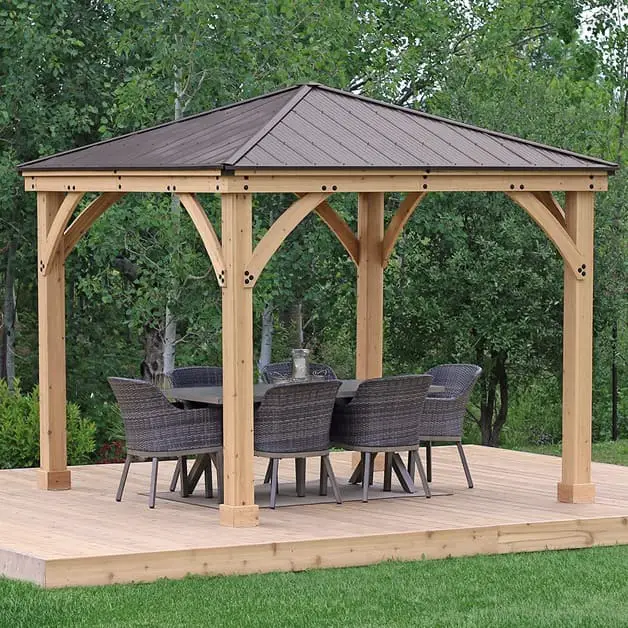
Zoning restrictions govern how the land can be used in a particular area, and local government authorities usually establish them.
These restrictions may limit the type of structures that can be built in a given area, the size and height of those structures, and the activities that can take place on the property.
Zoning restrictions can vary widely depending on the location and the property’s intended use. For example, a residential area may have zoning restrictions that prohibit commercial or industrial activities, while a commercial area may have restrictions that limit the height or size of buildings to ensure that they don’t block views or create safety hazards.
When building a wooden gazebo, it’s important to research and comply with all applicable zoning restrictions to ensure the structure is legal and permitted in the designated area.
This may involve obtaining permits or special permissions, and it may also require adhering to specific design and construction guidelines to ensure that the gazebo meets all necessary zoning requirements.
Consulting with a professional builder or architect can help ensure that the design and construction of the gazebo comply with all applicable zoning restrictions and guidelines and can help avoid potential legal or regulatory issues in the future.
Site-Specific Limitations for Building a Wooden Gazebo
Site-specific limitations refer to factors that may impact the design and construction of a wooden gazebo based on the location and characteristics of the site.
These limitations can include physical features of the site such as the slope of the ground or the presence of trees, as well as environmental factors such as wind or water exposure.
When planning the construction of a wooden gazebo, it’s important to consider any site-specific limitations and how they may impact the design and construction process.
For example, if the ground is sloped, the gazebo may need to be built on a foundation or platform to ensure that it is level and stable. If the site is exposed to high winds, the gazebo may need to be designed with reinforced framing or bracing to withstand the wind load.
In addition to physical and environmental limitations, there may also be legal or regulatory limitations that impact the construction of a wooden gazebo.
These may include setback requirements, determining how far the gazebo must be located from property lines or other structures, or environmental regulations that restrict building in certain areas to protect sensitive habitats.
Consulting with a professional builder or architect can help ensure that any site-specific limitations are properly considered in the design and construction of the gazebo, and can help avoid potential issues or delays during the construction process.
Examples of Wooden Gazebo Heights
The height range of a wooden gazebo can vary depending on its design, purpose, and location. However, here are some common height ranges for wooden gazebos:
Low-profile wooden gazebo
These types of wooden gazebos usually have a height range of 6 to 8 feet (1.8 to 2.4 meters). They are designed to be small and unobtrusive, often used as a decorative feature or a place to sit and relax in the garden.
Standard wooden gazebo
These types of wooden gazebos typically have a height range of 8 to 10 feet (2.4 to 3 meters). They are more substantial structures, often used for outdoor dining or entertaining.
Tall wooden gazebo
These types of wooden gazebos can have a height range of 10 to 14 feet (3 to 4.3 meters). They are usually designed with a high-pitched roof, allowing for maximum headroom and ventilation. They are often used as a shelter for outdoor events or as a focal point in a larger garden.
Factors Affecting the Height of a Gazebo
The height of a gazebo can vary based on location, style, and purpose. Here are some examples of how these factors can affect the height of a gazebo:
Location
The height of a gazebo can be influenced by the location in which it is built. For example, a gazebo built on a hill or elevated area may have a higher height to provide a better view. Similarly, a gazebo built in an area with low-hanging tree branches may need to be shorter to avoid obstruction.
Style
The style of the gazebo can also affect its height. For instance, a traditional style gazebo with a steep-pitched roof may have a higher height to accommodate the design. In contrast, a modern-style gazebo with a flat roof may have a lower height to fit with the sleek design.
Purpose
The purpose of the gazebo can also influence its height. For example, a gazebo designed for outdoor dining may need to have a higher height to accommodate tables and chairs. In contrast, a pavilion designed for relaxation may have a lower height to create a more intimate and cosy atmosphere.
FAQs
Q.1 What is the standard height of a gazebo?
A gazebo is a structure that people use for outdoor gatherings or events. The standard height of a gazebo is around 2.5 meters, but the width and length of the frame can change depending on what people want to use it for. A common size for a gazebo is 3 meters by 3 meters, which is good for small or medium sized events.
Q.2 What is the ideal size for a gazebo?
If you want a gazebo for small gatherings, a size of 12 feet by 12 feet is good. This size can seat a large family, or a family of four plus six guests comfortably. For bigger gatherings, gazebos that are 14 feet by 14 feet or 16 feet by 16 feet are good. These sizes can accommodate 12 to 15 people and are great for social events or business dinners.
Q.3 How high can my neighbor’s gazebo be?
When building a gazebo, there are rules about how tall it can be depending on how close it is to the edge of your property. If the gazebo is within 2 meters (about 6.5 feet) of the boundary, it can’t be taller than 2.5 meters (about 8.2 feet). If it’s further away from the boundary, it can be up to 3 meters (about 9.8 feet) tall. If the gazebo has a pitched roof, it can be as tall as 4 meters (about 13 feet).
Q.4 Does a wooden gazebo need planning permission?
If you want to build a small structure like a garden shed or gazebo, you probably won’t need to get permission first. But if you want to build a big oak framed garage, you might need permission. Don’t worry though, getting permission is usually easy and won’t cause too many problems.
Q.5 What is the best base for a wooden gazebo?
When building a gazebo, you need a good base to put it on. The base needs to be flat, level, and square. You can use concrete, paving slabs, or decking to make the base. Concrete is the best choice, but if you already have a flat paved or decked area in your garden, you can put the gazebo on top of that too.
Conclusion
The conclusion of this article is that the maximum height of a wooden gazebo is dependent on several factors, including structural considerations, design considerations, and local regulations. Ultimately, the height of a wooden gazebo should be carefully considered and planned to ensure that it meets all necessary requirements and serves its intended purpose.
After reading this guide How high can a wooden gazebo be, we hope you have a better understanding of how tall a wooden gazebo can be based on different factors. If you have any questions, please feel free to ask in the comments section below.

